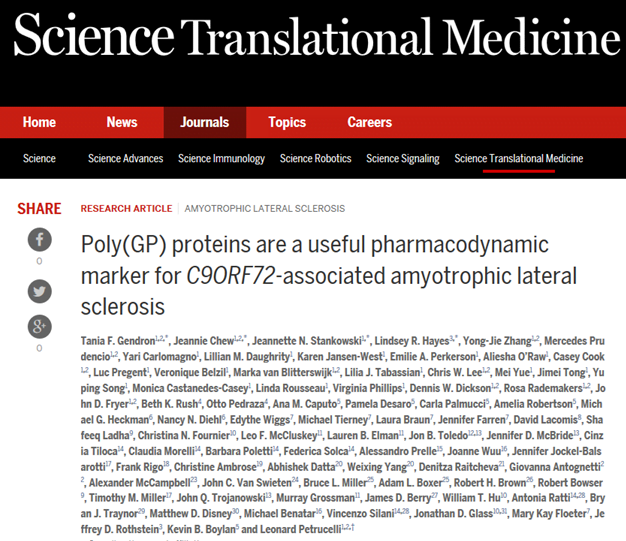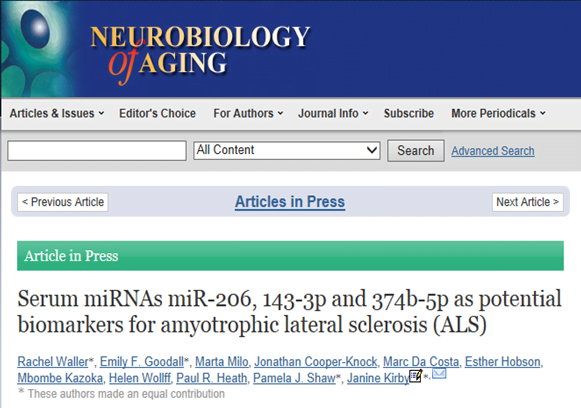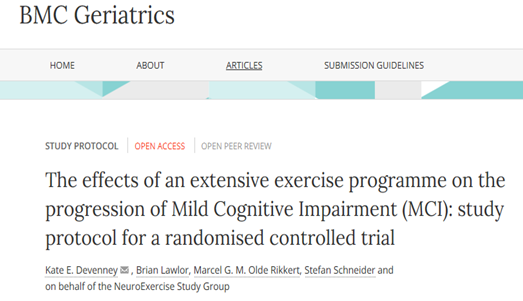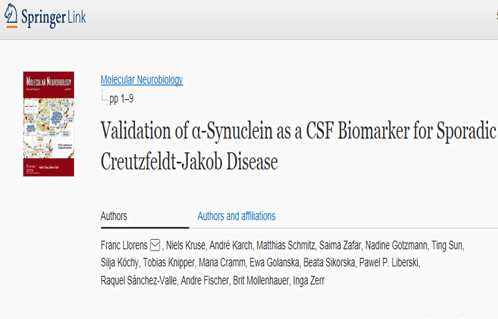 “Poly(GP) proteins are a useful pharmacodynamic marker for C9ORF72-associated amyotrophic lateral sclerosis” has been published in the journal Science Translational Medicine. This work was supported in part by JPND through the STRENGTH project, selected in the 2012 risk factors call.
“Poly(GP) proteins are a useful pharmacodynamic marker for C9ORF72-associated amyotrophic lateral sclerosis” has been published in the journal Science Translational Medicine. This work was supported in part by JPND through the STRENGTH project, selected in the 2012 risk factors call.
Yearly Archives: 2017
Progressive supranuclear palsy (PSP) is a brain disease that belongs to a group of neurological diseases referred to as tauopathies. PSP impairs eye movements, locomotion, balance control, and speech, and is currently incurable. Now scientists have discovered a molecular mechanism that may help in the search for effective treatments for PSP and potentially other tauopathies. Their study, which focuses on a protein called PERK (protein kinase RNA-like endoplasmic reticulum kinase), was published in EMBO Molecular Medicine.
In tauopathies, a molecule called tau forms clumps rather than stabilizing the cytoskeleton as it normally does. Affected neurons can degenerate or even perish. To prevent such events, pathological molecules are normally repaired or disposed of by the organism. The protein PERK is part of such a maintenance system. However, in PSP, this mechanism appears to be defective. In previous studies, the researchers had found that the risk for PSP is associated with variants of the PERK gene, and that loss of PERK function induces tau pathology in humans. For the current study, they examined the functioning of this protein more closely, to see how its effects could be positively influenced. To this end, they investigated samples of brain tissue from deceased patients, cell cultures and mice with a genetic disposition for PSP.
They found that the disease sequelae decrease when PERK is activated with pharmaceuticals. Their findings, the researchers say, show that PERK is an important part of the disease mechanism.
The scientists see potential for tackling other brain diseases because PERK helps eliminate the abnormal tau molecules that also occur in other diseases such as Alzheimer’s disease.
Paper: „A protein called PERK may be a target for treating progressive supranuclear palsy: Acting upon the maintenance system of neurons alleviates disease sequelae in laboratory experiments“
Reprinted from materials provided by DZNE- German Center for Neurodegenerative Disease.
 “Serum miRNAs miR-206, 143-3p and 374b-5p as potential biomarkers for amyotrophic lateral sclerosis (ALS)” has been published in the journal Neurobiology of Aging. This work has been supported in part by JPND through the STRENGTH project, selected in the 2012 risk factors call.
“Serum miRNAs miR-206, 143-3p and 374b-5p as potential biomarkers for amyotrophic lateral sclerosis (ALS)” has been published in the journal Neurobiology of Aging. This work has been supported in part by JPND through the STRENGTH project, selected in the 2012 risk factors call.

New research has shown that intestinal bacteria can accelerate the development of Alzheimer’s disease. According to the researchers behind the study, the results open up the door to new opportunities for preventing and treating the disease.
Because our gut bacteria have a major impact on how we feel through the interaction between the immune system, the intestinal mucosa and our diet, the composition of the gut microbiota is of great interest to research on diseases such as Alzheimer’s. Exactly how our gut microbiota composition is composed depends on several factors, including which bacteria we receive at birth, our genes and our diet.
By studying both healthy and diseased mice, the researchers found that mice suffering from Alzheimer’s have a different composition of gut bacteria compared to mice that are healthy. The researchers also studied Alzheimer’s disease in mice that completely lacked bacteria to further test the relationship between intestinal bacteria and the disease. Mice without bacteria had a significantly smaller amount of beta-amyloid plaque in the brain. Beta-amyloid plaques are the lumps that form at the nerve fibres in cases of Alzheimer’s disease.
To clarify the link between intestinal flora and the occurrence of the disease, the researchers transferred intestinal bacteria from diseased mice to germ-free mice, and discovered that the mice developed more beta-amyloid plaques in the brain compared to if they had received bacteria from healthy mice.
The researchers say that their study points to a direct causal link between gut bacteria and Alzheimer’s disease. As a next step, the researchers will test new types of preventive and therapeutic strategies based on the modulation of the gut microbiota through diet and probiotics.
Paper: “Reduction of Abeta amyloid pathology in APPPS1 transgenic mice in the absence of gut microbiota”
Reprinted from materials provided by Lund University.
 “The effects of an extensive programme on the progression of Mild Cognitive Impairment (MCI): study protocol for a randomized controlled trial” has been published in the journal BMC Geriatrics. This work was supported by JPND through the NeuroExercise project, selected in the 2013 preventive strategies call.
“The effects of an extensive programme on the progression of Mild Cognitive Impairment (MCI): study protocol for a randomized controlled trial” has been published in the journal BMC Geriatrics. This work was supported by JPND through the NeuroExercise project, selected in the 2013 preventive strategies call.
Tiny particles that pollute the air — the type that mainly comes from power plants and automobiles — may greatly increase the chance of dementia, including Alzheimer’s disease, according to new research.
Scientists and engineers have found that older women who live in places with fine particulate matter exceeding the U.S. Environmental Protection Agency’s standard are 81 percent more at risk for global cognitive decline and 92 percent more likely to develop dementia, including Alzheimer’s. If their findings hold up in the general population, air pollution could be responsible for about 21 percent of dementia cases.
The adverse effects were stronger in women who had the APOE4 gene, a genetic variation that increases the risk for Alzheimer’s.
The study, published in Translational Psychiatry, adds to an emerging body of research from around the world that links air pollution to dementia. The offending pollutants — known as PM2.5 — are fine, inhalable particles with diameters 2.5 micrometers or smaller.
The researchers analyzed data of 3,647 65- to 79-year-old women. These women lived across 48 U.S. states and did not have dementia when they enrolled. The researchers adjusted for potential bias associated with geographic region, race or ethnic background, education, socioeconomic status, lifestyle and medical conditions.
The researchers said more research is needed to confirm a causal relationship and to understand how air pollution enters and harms the brain. Accurate pollution monitors are important for this task. In addition, future studies will need to include both sexes to evaluate generalizability to men as well as examine how PM2.5 interacts with cigarettes and other pollutants.
Paper: “Reduction of Abeta amyloid pathology in APPPS1 transgenic mice in the absence of gut microbiota”
Reprinted from materials provided by Lund University.
 “Genetic assessment of age-associated Alzheimer disease risk: Development and validation of a polygenic hazard score” has been published in the journal PLOS Medicine. This work was supported in part by JPND through the APGeM project, selected in the 2012 risk factors call.
“Genetic assessment of age-associated Alzheimer disease risk: Development and validation of a polygenic hazard score” has been published in the journal PLOS Medicine. This work was supported in part by JPND through the APGeM project, selected in the 2012 risk factors call.
 Biologists have known for decades that enduring a short period of mild stress makes simple organisms and human cells better able to survive additional stress later in life. Now, scientists have found that a cellular process called autophagy is critically involved in providing the benefits of temporary stress. The study, published in Nature Communications, creates new avenues to pursue treatments for neurological disorders such as Huntington’s disease.
Biologists have known for decades that enduring a short period of mild stress makes simple organisms and human cells better able to survive additional stress later in life. Now, scientists have found that a cellular process called autophagy is critically involved in providing the benefits of temporary stress. The study, published in Nature Communications, creates new avenues to pursue treatments for neurological disorders such as Huntington’s disease.
Autophagy is a means of recycling cells’ old, broken, or unneeded parts so that their components can be re-used to make new molecules or be burned for energy. The process had previously been linked to longevity. The new results suggest that long life and stress resistance are connected at the cellular level.
The scientists incubated C. elegans — tiny roundworms used to study fundamental biology — at 36 °C, significantly above the temperature they are usually kept at in the laboratory, for one hour. After this short heat exposure—a mild form of stress that improves the organism’s survival—autophagy rates increased throughout the worms’ tissues. When they exposed these heat-primed worms to another, longer heat shock a few days later, worms that were deficient in autophagy failed to benefit from the initial mild heat shock, as observed in heat-primed worms with intact autophagy.
The researchers reasoned that a mild heat stress might also improve the worms’ ability to handle another condition that worsens with age—buildup of aggregated proteins, which is stressful for cells. To test this hypothesis, they used worms that model Huntington’s disease, a fatal inherited disorder caused by neuronal proteins that start to stick together into big clumps as patients age, leading to degeneration throughout the brain. Exposing worms that make similar sticky proteins in different tissues to a mild heat shock reduced the number of protein aggregates, suggesting that a limited amount of heat stress can reduce toxic protein aggregation.
The researchers say that their findings could suggest new paths to slowing a range of neurodegenerative diseases, including Huntington’s disease, Alzheimer’s disease, and Parkinson’s disease.
Paper “Hormetic heat stress and HSF-1 induce autophagy to improve survival and proteostasis in C. elegans”
Reprinted from materials provided by Sanford Burnham Prebys Medical Discovery Institute
 “Validation of α-Synuclein as a CSF Biomarker for Sporadic Creutzfeldt-Jakob Disease” has been published in the journal Molecular Neurobiology. This work was supported in part by JPND through the DEMTEST project, selected in the 2011 biomarkers call.
“Validation of α-Synuclein as a CSF Biomarker for Sporadic Creutzfeldt-Jakob Disease” has been published in the journal Molecular Neurobiology. This work was supported in part by JPND through the DEMTEST project, selected in the 2011 biomarkers call.
An international team of scientists has developed a novel genetic score that allows individuals to calculate their age-specific risk of developing Alzheimer’s disease (AD) based upon genetic information.
A description of the polygenic hazard scoring (PHS) system and its validation were published in PLOS Medicine.
The researchers combined genotype-derived polygenic information with known AD incidence rates from the U.S. population to derive instantaneous risk estimates for developing AD.
To conduct the study, the research team analyzed genotype data from more than 70,000 AD patients and normal elderly controls who were participating in several projects, such as the Alzheimer’s Disease Genetics Consortium, the National Alzheimer’s Coordinating Center and the Alzheimer’s Disease Neuroimaging Initiative. The team scrutinized the data for AD-associated single nucleotide polymorphisms (SNPs), which are variations of a single nucleotide or DNA building block that occur at a specific position in the genome. There is some SNP variation in genomic information in all humans, which affects individual susceptibility to disease. In this case, the researchers looked at SNPs linked to AD risk and for APOE status. Persons with the E4 variant in the APOE gene are known to be at greater risk of developing late-onset AD.
The researchers developed a continuous polygenic hazard score or PHS based upon this data to predict age-specific risk of developing AD, then tested it in two independent cohorts or defined groups of people. They found persons in the top PHS quartile developed AD at a considerably lower age and had the highest yearly AD incidence rate. Importantly, PHS also identified people who were cognitively normal at baseline but eventually developed AD. Even among people who did not have the APOE E4 allele, the most important genetic risk factor for AD, PHS informed age of onset; individuals with high PHS scores developed AD 10-15 years earlier than individuals with low PHS.
The authors found that PHS strongly predicted empirical age of AD onset and progression from normal aging to AD, with strongly associated neuropathology and biomarkers of AD neurodegeneration.
Paper “Genetic assessment of age-associated Alzheimer disease risk: Development and validation of a polygenic hazard score”
Reprinted from materials provided by University of California San Diego
